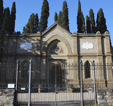Partner House of the Association
Monumental cemetery
In the so called English Cemetery of Porta a Pinti, in Piazza Donatello in Florence, are buried the most varied foreign personalities who, in the eighteenth century, had chosen Florence as the home of their cultural and economic life. The cemetery is part of the UNESCO Heritage, of the ASCE, of the Cultural Route of the European Council and is well protected by the Ministry of Cultural Heritage.
The English Cemetary , owned by the Swiss Reformed Church in Florence, is a place of historical, religious and cultural witness which was born because of a discrimination: at the beginning of the 19th century non-Catholics were not accepted in the cemeteries of the City and the closest place to burial the Protestants in Florence was Livorno. So there was a need for a Cemetary in Florence with the vocation to be multicultural, multinational and multireligious.
The Cemetery was opened by the Reformed Church of Switzerland in Florence in 1827 thanks to the granting of Grand Duke Leopold II of Lorraine. And few years ago, after being closed for about a century, it reopened, hosting only ashes and maintaining its original vocation of welcoming everyone.
The cemetery inside has a library and the video and tape library of Fioretta Mazzei.
The Cemetery, with approximately 1400 tombs of 16 countries, has many English tombs and this is why it is called English. But there are buried people from Switzerland, United States, and from so many other nations. Among the prominent figures here we find: Elizabeth Barrett Browning, English poet and Giovan Pietro Vieusseux, Swiss writer and publisher.
Born outside the walls of the door called Porta à Pinti was later found inside the city after the arch. Poggi restored it for the move of the capital of the Kingdom of Italy to Florence in 1861. All this has made its position of "island" particularly interesting within the new ring road of Florence.
Various cultural events have been held in recent years in order to enhance and make the cemetery a living place of culture.








